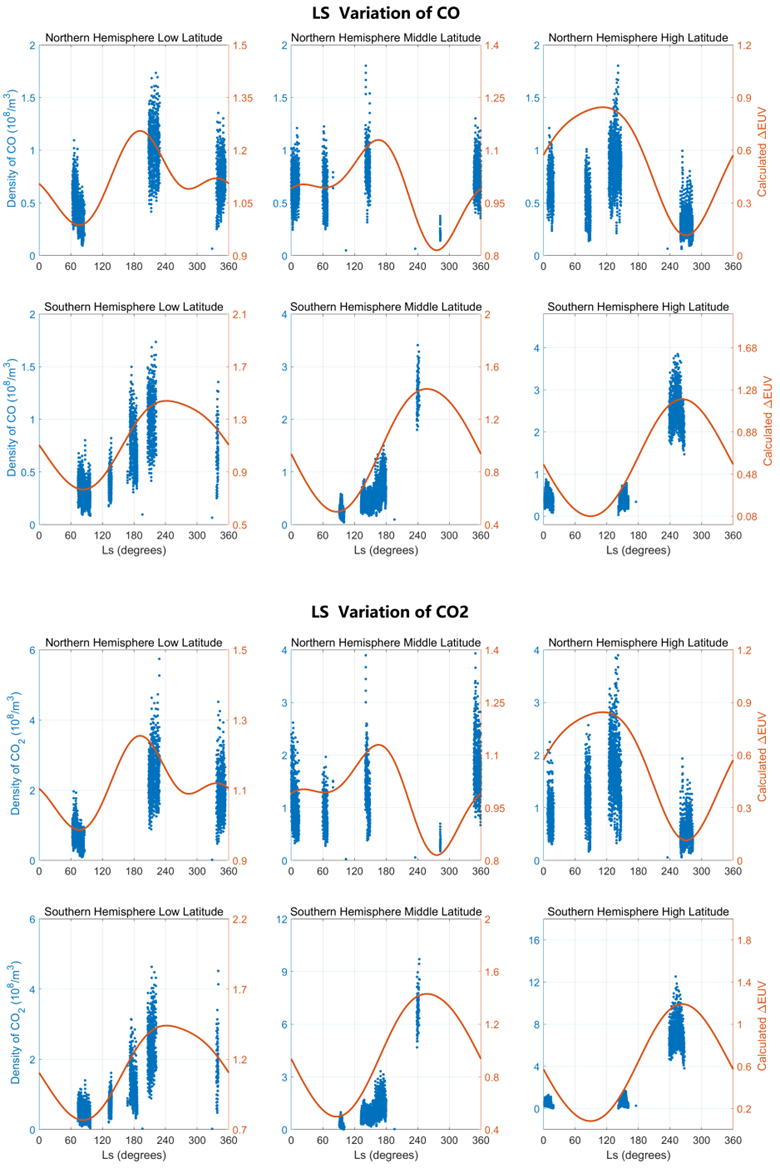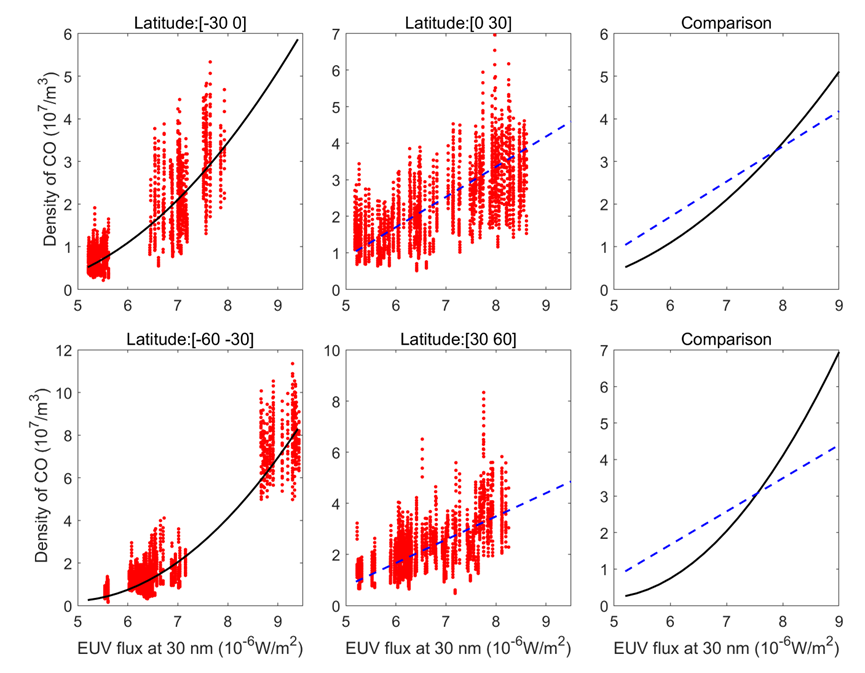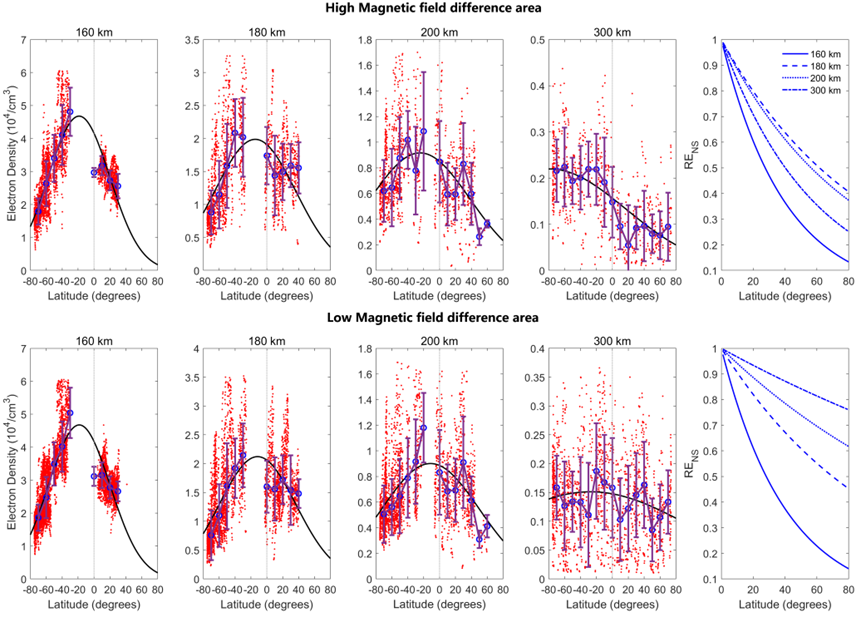Music Army et al.
Author:Institute of Geological Earth Time:2022.06.25


Mars high -level atmosphere (including ionization layer and thermal layer) is an important foundation for understanding the entire Mars's atmospheric evolution and an important source of Mars atmosphere escape. Therefore, it has become an important goal of Mars detection. Multiple detection, such as Mars Express, Mars atmosphere and Volatal Evolutionary Exploration (Maven), "Tianwen No. 1". The high -level atmosphere changes on Sunday or day by day are affected by the spread of various fluctuations in the low -level atmosphere. This disturbance effect has related events in the short -term scale, but the coupling process of long -term climatic science scale is not clear. Maven is the first spacecraft to directly measure Martian atmosphere. It has accumulated data that has accumulated more than eight years (2015-2022), which provides good conditions for studying Mars atmosphere asymmetry from the hemisphere of Mars. Researchers for the first time the Maven Data Researcher of the Geological and Planets Institute of Geology and Earth Physics Institute of the Chinese Academy of Sciences used Maven data for the first time to conduct research on the coupling process of low -level atmosphere and high -level atmosphere in climatic studies and its influence.
Based on the calculation of the sun's roof and the distance from Mars to the sun, they found that the strongest changes in the seasons of the solar EUV flux appeared in the high latitude area of the southern hemisphere and the weakest appeared in the low latitudes of the northern hemisphere. CO and CO2 density have the same changes (Figure 1). Observation and simulation calculations indicate that the seasonal changes in the southern hemisphere are more significant than the northern hemisphere, because the distance from Mars to the sun is the same as that of the Sun Euv flux in the southern hemisphere, but in the opposite direction of the northern hemisphere.
In order to further study the differences between the Mars high-level atmosphere north-south hemisphere, it is necessary to minimize the differences in the north and south hemisphere of solar radiation. Therefore, they first statistically analyzed the lower solar activity (2016-2021) spring points (between LS between 150 and 210) The data. Curve fitting and median results indicate that the density of neutral CO and CO2 has a very obvious latitude structure (Figure 2). The maximum density is located near the equator. With the increase of the latitude of the north and south hemisphere, the density gradually decreases. These results also clearly indicate the asymmetry of the neutral atmosphere. Overall, during the lower solar activity period, the neutral density of the northern hemisphere was higher than that of the southern hemisphere.
In addition, they analyzed the observation data of the strong period of solar activity (2014-2015), and the results also showed significant north-south asymmetry, but the neutral density of the northern hemisphere was lower than that of the southern hemisphere. In other words, the differences between the high -level atmosphere north -south hemisphere are significantly different during different solar activities. Figure 3 shows the changes in the asymmetry of the north -south hemisphere of the hot layer at the atmospheric density. They also statistically analyzed the asymmetry of the north and south hemispheres of ionized electronic density. As a result, the result of the asymmetry of the hemisphere of the ionized electronic density as the asymmetric hemisphere of the electronic density of the hot layer also has significant solar activity dependence. Under the conditions of lower solar activity, the electronic density of the northern hemisphere is greater than the southern hemisphere. As the solar radiation increases, the electronic density of the southern hemisphere gradually exceeds the northern hemisphere. However, the electronic density of the ionization layer is different from the asymmetrical converting threshold of the hemisphere hemisphere of the thermal layer. The specific reasons need to be further studied.

Figure 1 Mars of the Mars atmosphere data at the atmospheric density data of 180 km at the height of CO and CO2 changes in the height

Figure 2 The latitude structure of the thermal layer CO and CO2 in different heights

Figure 3 Thermal layer CO density changes with solar radiation in different latitude areas in the north and south hemisphere
As we all know, there is a significant north -south hemisphere asymmetric in the terrain of Mars, and there is a strong hemisphere difference in the remaining magnetic fields of Mars. On the one hand, the huge hemisphere difference between the Mars and the following sand storms may also cause hemisphere differences in low -level atmospheric fluctuations. Various fluctuations in low -level atmosphere spread upward and enter the high -level atmosphere that affects the ingredients and density. On the other hand, the Mars magnetic field has a direct control of high -level atmospheric electrical particles, which may affect the distribution of high -level atmospheric electronic density and neutral atmospheric density. So what aspect of Maven's high -level atmosphere of the Mars high -level atmosphere is mainly from? How to affect the high -level atmosphere in the climate of Mars low -level atmosphere, the existing observation data is insufficient, and it is difficult to use these data to study the hemisphere differences in the process of low -level atmosphere and high -level atmosphere coupling. However, the impact of the planet's magnetic field on the high -level atmosphere has more understood, and some studies have discussed the impact of Mars magnetic field on the ionization and thermal layer of Mars. In addition, the difference between Mars North and South Hemisphere Magnetic field depends to a large extent on the longitude. Between the longitude and 240 °, the southern hemisphere has a strong rock remaining magnetic field, while the northern hemisphere magnetic field is weak. In other longitude areas, the magnetic field between the north and south hemispheres is small. This provides natural experimental conditions for testing the influence of magnetic field differences. Therefore, the relationship between planetary magnetic field differences and ionized thermal layers of the north -south can be tested by the results of two areas with different magnetic field differences.
By analyzing the results of high magnetic field differences and low magnetic field differences, it is found that the north -south differences of the Mars magnetic field may increase the north -south difference in electronic density at a higher height greater than 200 km, but the north -south differences and neutrality of the electronic density of the electronic density below 200 km below 200 km below 200 km below The atmospheric density basically has no effect. It can be concluded that preliminary conclusions are that the electronic density and neutral atmospheric density of the ionization layer and the thermal layer of the Spring and Autumn Period are not caused by the differences between the north and the south of the remaining magnetic field of the Mars rock, but the process with the low -level atmospheric fluctuations with the low -level Mars The difference between North and South. There are huge differences between the terrain northern and southern of Mars, which leads to the differences between the north -south differences of various volatility processes (such as gravity waves, tide, and planetary waves) in the low -level atmosphere, and the dust violence in the low -level atmosphere. The low -level atmospheric hemisphere difference is uploaded to the high level at the atmosphere, causing the high -level atmosphere to be wrong. For the coupling process of such low -level atmosphere and high -level atmosphere and the hemisphere differences in climatic science, it will further reveal its main physical process in combination with observation and simulation. Figure 4 Comparison of electronic density and latitude changes in the electronic density of the high magnetic field difference between the north and the south hemisphere and the low magnetic field differences

Through the study of climate statistics of Mars's high -level atmospheric and latitude structure, the study discovered the significant asymmetry of the north and south hemisphere. During the lower solar activity, the ionizing electronic density and the neutral gas density of the northern hemisphere were greater. The increase in solar activity, the electronic density and neutral density of the southern hemisphere gradually exceeded the northern hemisphere. By analysis, this asymmetric is likely to come from the asymmetry of the hemisphere of the low -level atmosphere, which affects the high -level atmosphere through the coupling of the low -level atmosphere and the high -level atmosphere. The study revealed the coupling process and influence of Mars's low -level atmosphere and high -level atmosphere at the scale of climate science, and provided an important reference for the long -term evolution of the entire Mars atmosphere.
Research results published in international academic journals JGR: Planets (Music Army, Liu Libo, Chen must, Zhang Hui. South asymmetry of Martian Ionosphere and thermosphere. Journal of geophysical research: Planets, 2022, E2021212121212122122122222222222222222222222222222222222. 10.1029/2021je007143). Research was jointly funded by the Chinese Academy of Sciences Pioneer B (XDB41000000), the Ministry of Science and Technology's key R & D plan project (2018YFC1503504), the National Natural Science Foundation of China (41822403, 41774165) and the Youth Innovation Promotion Association of the Chinese Academy of Sciences.
Beauty editor: Fu Shixu

School pair: Wanpeng
- END -
B -side visual trend analysis

Edit Introduction: Affected by the major environment, lifestyle changes, and many ...
Consul General Jiang Wei attended the 75th anniversary celebration meeting of the establishment of the National Academy of Sciences of Kazakhstan

On June 1, the National Academy of Sciences of Kazakhstan held a grand meeting of ...